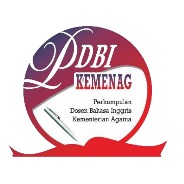Error Analysis of English Sentence Structure in Students’ Written Paragraphs
Abstract
This research aimed to find out the types of sentence structure errors in English paragraphs written by tertiary English students and the factors causing the errors. This research employed an explanatory mixed-method design. Fourth-semester students from the English department of IAIN Curup were engaged as the subjects of this research. Positivism-governed document analyses and constructivism-based interviews were conducted to solicit the data as desired. The quantitative findings garnered from document analyses endorsing a ready-to-use construct proposed by Dulay, Burt, and Krashen (1982), revealed that there were four types of sentence structure errors students made, namely omission, addition, misformation, and misordering. Those types of errors were exhibited in a proximate composition which meant that the students had compatible difficulties in terms of the four types of errors. As uncovered from students' writing works, the four types of errors were found in the domains of words, phrases, and clauses. Subsequently, the qualitative findings, elicited from interviews, demonstrated that the factors of sentence structure errors extended to students' mother tongue interference, overgeneralization in the use of English rules and norms, and the lecturer's teaching material delivery and method. Anchored in the data gained, this research discussed the data from the perspective of interlanguage theory, wherein some reviews of SLA and EFL pedagogy-related theories were offered to help lower the factors causing English sentence structure errors in writing skills.
Keywords: Errors, Sentence Structure, English writing skill
Full Text:
PDFReferences
Al-hroub, A., Shami, G., & Evans, M. (2017). The impact of the ‘writers’ workshop’ approach on the L2 English writing of upper-primary students in Lebanon. The Language Learning Journal, 1–13. https://doi.org/10.1080/09571736.2016.1249394
Ary, D., Jacobs, L. C., Sorensen, C. K., Walker, D. A., & Razavieh, A. (2010). Introduction to research in education. Measurement (8th ed., Vol. 4). USA: Wadsworth, Cengage Learning. https://doi.org/10.1017/CBO9781107415324.004
Burner, T. (2015). Formative assessment of writing in English as a foreign language. Scandinavian Journal of Educational Research, 1–23. https://doi.org/10.1080/00313831.2015.1066430
Bussmann, H.(1996).Routledge dictionary of language and linguistics.London: Routledge.
Byram, M. (1986). Cultural studies in foreign-language teaching. Language Teaching, 19, 322–336. https://doi.org/10.1017/S0261444800011101
Chen, W., & Yu, S. (2019). Implementing collaborative writing in teacher-centered classroom contexts: student beliefs and perceptions. Language Awareness, 1–21. https://doi.org/10.1080/09658416.2019.1675680
Chong, S. W. (2018). The use of exemplars in English writing classrooms: from theory to practice. Assessment & Evaluation in Higher Education, 1–16. https://doi.org/10.1080/02602938.2018.1535051
Corder, S. P. (1981). Error analysis and interlanguage. Oxford: Oxford University Press.
Creswell, J. W. (2007). Qualitative inquiry & research design:
Choosing among five approaches (2nd ed.). USA: SAGE publications, Inc.
Crystal, D. (2008). Two thousand million? English Today, 24(01), 3–6. https://doi.org/10.1017/S0266078408000023
Datchuk, S. M., & Rodgers, D. B. (2019). Text writing within simple sentences: A writing fluency intervention for students with high‐incidence disabilities. Learning Disabilities Research & Practice, 34(1), 23–34.
Deane, P. (2018). The challenges of writing in school: conceptualizing writing development within a sociocognitive framework. Educational Psychologist, 1–21. https://doi.org/10.1080/00461520.2018.1513844
Demirezen, M. (2012). An analysis of the problem-causing structures of simple sentences for Turkish university Students. International Journal of Humanities and Social Science, 2(3), 135–146.
Depraetere, I., & Langford, C. (2020). Advanced English grammar: A linguistic approach. USA: Bloomsbury Publishing Plc.
Dulay, H., Burt, M., & Krashen, S. D. (1982). Language two. New York: Oxford University Press.
Edwards, H., Wesche, M., Krashen, S., Clement, R., & Kruidenierr, B. (1985). Second-language acquisition through subject-matter learning: a study of sheltered subject matter classes at the University of Ottawa. The Canadian Modern Language Review, 41, 268–282.
Ellis, R. (1992). Instructed second language acquisition. UK: BLACKWELL.
Faraj, A. K. A. (2015). Scaffolding EFL Students’ Writing through the Writing Process Approach. Journal of Education and Practice, 6(13), 131–141.
Fauziati, E. (2014). Methods of Teaching English as a Foreign Language. Surarta: Era PustakaUtama.
Fraenkel, J. R., Wallen, N. E., & Hyun, H. H. (2012). How to design and evaluate research in education. 1221 Avenue of the Americas, New York, NY 10020: McGraw-Hill Companies, Inc. https://doi.org/10.1017/CBO9781107415324.004
Gall, M. D., Gall, J. P., & Borg, W. R. (2003). Educational research: An introduction (7th ed.). USA: Allyn and Bacon.
Graham, S., Liu, X., Aitken, A., Ng, C., Bartlett, B., Harris, K. R., & Holzapfel, J. (2017). Effectiveness of literacy programs balancing reading and writing instruction: A meta-analysis. Rreading Research Quarterly, 1–26. https://doi.org/10.1002/rrq.194
Han, C., & Fan, Q. (2019). Using self-assessment as a formative assessment tool in an English-Chinese interpreting course: student views and perceptions of its utility. Perspectives, 1–17. https://doi.org/10.1080/0907676X.2019.1615516
Hartsuiker, R. J., Pickering, M. J., & Veltkamp, E. (2004). Is Syntax Separate or Shared between Languages? Cross-Linguistic Syntactic Priming in Spanish-English Bilinguals. Psychological Science, 15(6), 409–414.
Hendrawaty, N. (2018). An analysis on students’ errors in writing sentence patterns. LOQUEN, 11(1), 63–85.
Jacobs, M. (2020). English grammar rules & mistakes: learn all of the essentials: writing, speaking, literature and punctuation rules complete with 10 key skills and over 200 common error examples. UK: Independently publisher (Jacobs, Melony ).
James , C. (1980). Contrastive analysis. Singapore: Longman Group Ltd.
Kachru, B. B., Kachru, Y., & Nelson, C. L. (2006). The handbook of world Englishes. Oxford: Blackwell.
Kachru, Braj B. (1990). World Englishes and applied linguistics. World Englishes, 9(1), 3–20.
Kramsch, C. (2013). Culture in foreign language teaching. Iranian Journal of Language Teaching Research, 1(1), 57–78.
Krashen, S. D. (1981). Second language acquisition and second language learning. California: Pergamon Press Inc.
Krashen, S. D. (1982). Principles and practice in second language acquisition. California: Pergamon Press Inc.
Krashen, S. D. (2004). The power of reading: insights from the research. London: Heinemann Publishers Ltd.
Lado, R. (1957). Linguistics acrosscultures: Applied linguistics for language teachers. Ann Arbor, MI:University of Michigan Press.
Lantolf, J. P., & Thorne, S. L. (2006). Sociocultural Theory and Second Language Learning. Theories in Second Language Acquisition, 197–221. https://doi.org/10.1177/0022219409345018
Laufer, B., & Nation, P. (1995). Vocabulary size and use: Lexical richness in L2 written production. Applied Linguistics, 16(3), 307–322.
Liao, W. R. (2014). On modification with whole / zheng in English and Chinese and the uniformity of syntax. J East Asian Linguist, 1–22. https://doi.org/10.1007/s10831-014-9122-x
Mahmood, A. H., Mohammed, I., & Murad, A. (2018). Approaching the Language of the Second Language Learner: Interlanguage and the Models Before. English Language Teaching, 11(10), 95–108. https://doi.org/10.5539/elt.v11n10p95
Mason, B., & Krashen, S. (1997). Extensive reading in English as a foreign language. System, 25, 91–102.
Miles, M. B., Huberman, A. M., & Saldana, J. (2014). Qualitative data analysis: A methods sourcebook. Thousand Oaks, California 91320: SAGE Publications, Inc.
Morganna, R. (2017a). Teachers’ attitudes towards conducting interlanguage analysis to prepare better instructions. International Journal of Pedagogy and Teacher Education (IJPTE), 1(2), 127–138. https://doi.org/http://dx.doi.org/10.20961/ijpte.v1i2.15080
Morganna, R. (2017b). Theoretical, pedagogical, practical views, and the shift of genre based instruction. English Franca, 1(1), 81–100. https://doi.org/http://dx.doi.org/10.29240/ef.v1i1
Murphy, R. (2019). English grammar in use: Book with answers and interactive ebook: A self-study reference and practice book for intermediate learners of English. UK: Cambridge University Press.
Myers, J. L., Well, A. D., & Lorch, R. F. (2010). Research desgin and statistical analysis. New York: Routledge.
Napitupulu, S., & Manalu, D. B. (2018). Students’ Paragraph Structure in Writing Research Background. LPPM Universitas HKBP Nommensen.
Nation, P. (2001). Learning vocabulary in another language. Cambridge: Cambridge University Press.
Nation, P. (2014). What do you need to know to learn a foreign language? New Zealand: School of Linguistics and Applied Language Studies Victoria University of Wellington.
Oppenheim, A. N. (2001). Questionnaire design, interviewing and attitude measurement. London: Continuum.
Osborne, T. (2019). A dependency grammar of English: An introduction and beyond. UK: John Benjamins.
Putri, P. S., & Dewanti, A. (2014). An analysis of grammatical errors in writing narrative texts done by the second semester students at the diploma program English department in Airlangga University Surabaya. Anglicist Volume, 3(1), 1–7.
Richards, J. C, Platt, J. & Platt, H. (1992). Dictionary of language teaching and applied linguistics. Essex: Longman.
Silalahi, R. M. (2014). Error analysis on information and technology students’ sentence writing assignments. IJEE, 1(2), 1–16.
Torres-Gouzerh, R. (2019). Practice Makes Perfect : Intermediate English Grammar for ESL Learners. UK: McGraw-Hill Education.
Turuk, M. C. (2008). The relevance and implications of Vygotsky’s sociocultural theory in the second language classroom. ARECLS, 5, 244–262.
Uzun, K., & Topkaya, E. Z. (2019). The Effects of Genre-Based Instruction and Genre- Focused Feedback on L2 Writing Performance. Reading & Writing Quarterly, 1–24. https://doi.org/10.1080/10573569.2019.1661317
Vygotsky, L. (1978). Interaction between learning and development. Readings on the Development of Children. New York. https://doi.org/10.1016/S0006-3495(96)79572-3
Webb, S., & Nation, P. (2017). How vocabulary is learned. Oxford: Oxford University Press.
Worden, D. (2018). Balancing stability and flexibility in genre-based writing instruction: A case study of a novice L2 writing teacher. Journal of Second Language Writing, 1–14. https://doi.org/10.1016/j.jslw.2018.09.003
Wulandari, I. (2014). Grammatical errors found in articles’ abstracts of Indonesian scholarly journals. JEELS, 1(1), 12–30.
Yang, S. (2014). The Functions of the Nontarget Be in the Written Interlanguage of Chinese Learners of English. Language Acquisition, 21, 279–303. https://doi.org/10.1080/10489223.2014.892942
Yeo, N., & Tsoulas, G. (2013). The syntax of distributivity in a contact variety of English. Lingua, 127, 14–38. https://doi.org/10.1016/j.lingua.2013.01.004
DOI: http://dx.doi.org/10.29240/ef.v5i1.2173
Refbacks
- There are currently no refbacks.
Copyright (c) 2021 Dike Sundari, Jumatul Hidayah, Sarwo Edy, Farida Esmianti

This work is licensed under a Creative Commons Attribution-NonCommercial-ShareAlike 4.0 International License.
INDEXED BY:
 This work is licensed under a Creative Commons Attribution-NonCommercial-ShareAlike 4.0 International License
This work is licensed under a Creative Commons Attribution-NonCommercial-ShareAlike 4.0 International License
@ ENGLISH FRANCA : Academic Journal of English Language and Education
Jl. Dr. AK Gani No 1 Dusun Curup, Rejang Lebong Regency, Bengkulu Province, Indonesia, 39119.
Dr. Eka Apriani, M.Pd., email: efranca@iaincurup.ac.id, eka.apriani@iaincurup.ac.id.




.png)












